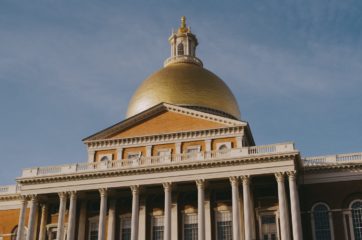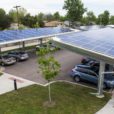The much anticipated GreenWorks bill is finally here! Is that too much excitement over the contents of a bonding bill? Well, it shouldn’t be.
Even if you’re not a climate wonk (like me) who has waited almost three months for the details of Speaker DeLeo’s $1.3 billion promise to cut carbon emissions, fortify infrastructure, and slash municipal climate costs, GreenWorks is important, and deserves an in depth look.
Why is it so important? When first announced, GreenWorks represented the first time in recent years that the Massachusetts House, under Speaker DeLeo’s leadership, seemed to be taking bold and proactive action in dealing with the core causes of climate change. During his speech at the cleantech incubator Greentown Labs, Speaker DeLeo promised to help communities across Massachusetts adopt green technologies, but at the time was sparse on details. That was until the GreenWorks bill itself (HD.4234) was released on Tuesday (May 28th, 2019).
My overall characterization of the bill’s impact on climate change: meh. Here’s why.
Its main focus is funding climate adaptation and local resilience. Despite spending over a billion dollars, GreenWorks is unlikely to significantly invest in much needed local climate change mitigation, nor does it considerably boost the local cleantech economy. GreenWorks therefore does not replace the need for other bolder policies that deal with carbon emissions in a significant way (i.e. carbon pricing).
Below are my top four takeaways from reading the GreenWorks bill.
[For a detailed summary of GreenWorks click here]
1. GreenWorks does little to mitigate climate change
Massachusetts needs to significantly reduce its carbon emissions from transportation (which account for 43% of state emissions), heating (25%), and industry (10%) by 2050 to meet its legally binding climate change goals. This requires policies that price carbon pollution in these sectors, while also significantly investing in new technologies that reduce emissions. Done right, this has the added benefit of growing the state’s economy, creating local jobs, and boosting cutting edge industries like cleantech.
GreenWorks does not come close to meaningfully reducing carbon emissions. For one, it primarily serves municipalities and does not encourage private sector vehicle electrification or microgrid deployment. The focus is then further narrowed as GreenWorks only targets a small subset of municipal emissions, those from light-duty vehicles, city owned buses, and some electric use. We certainly should target emissions from these sources, however, they will do little to help reach the state’s goals because they account for such a small percentage of its total carbon pollution.
Moreover, the GreenWorks bill does not adequately remove all the obstacles facing municipalities in reducing this already small subset of carbon pollution. HD.4234 only minimally lowers financial barriers for communities that want to fight climate change, authorizing $100 million to promote municipal microgrids, and another $115 million for electrification of town or city owned light-duty vehicles and/or buses. The details matter though. For microgrids, state funds would be capped at $4 million per project with a requirement for the municipality to fund between 50% and 99% of the total project costs. Meanwhile, all funds given to localities for vehicle electrification only cover the difference between the electric vehicle and a similar non-electric vehicle. Communities still have to have the resources to fully fund an overhaul of their existing fleet, probably somewhere over 60% of the cost of any given electric vehicle.
It’s important to keep in mind the scope of GreenWorks. Yes, it provides new mitigation tools to cities and towns that they didn’t have access to before; but these tools will put only a small dent into Massachusetts’ total emissions. GreenWorks does not replace the need for a bill(s) that significantly deals with carbon pollution.
2. GreenWorks will (probably) mostly fund climate adaptation
GreenWorks was announced by Speaker DeLeo as a solution to both the state’s mitigation needs (stopping climate change from getting worse), and its adaptation needs (preparing for the climate impacts that are already happening). Yet, the bill as written makes it more likely that funding will be used for climate adaptation and resilience.
$1 billion from the bill is dedicated to what’s called the ‘GreenWorks infrastructure program.’The bill has broad language authorizing program spending on (1) adaptation initiatives like the existing MVP program, (2) implementing resiliency measures, and also (3) placing renewable energy in municipally owned land to create microgrids. The language is quite vague though (see takeaway number 4 below), giving Governor Baker the ability to designate how much of the $1 billion goes to each of these. The Governor could put 100% into renewable energy (mitigation), or 100% into the MVP program (adaptation), or some combination of both.
Given the political landscape on Beacon Hill, and the Governor’s other options, I’m willing to bet implementation will skew heavily towards programs promoting adaptation. This session the Governor filed a bill placing a new tax on all real estate transfers that, if passed, would also raise around a billion dollars for climate adaptation. The bill is likely to receive intense opposition from the powerful real estate lobby, and may suffer the same fate of a bill last session that would require home sellers to score their energy efficiency, which failed due to real estate opposition. If his real estate transfer tax fails to gain traction, it’s not a stretch to imagine the Governor shifting focus to GreenWorks, which could also provide a billion dollars for adaptation and has support from House leadership. The Governor would then likely design the program to focus almost exclusively on adaptation.
3. The House is creatively side-stepping Governor Baker
One interesting aspect of the GreenWorks bill is that, as written, it appears to circumscribe some of Governor Baker’s ability to prevent its spending. If so, this has the effect of side-stepping Governor Baker’s aversion to debt spending, a concern for anyone trying to implement a bond bill. Let me explain how.
GreenWorks is a bond bill, meaning it authorizes the state to borrow a large sum of money upfront, with payment spread out over multiple decades. Such borrowing is common in states, and is a healthy part of any state budget, as it gives the state an opportunity to invest in things like transportation and economic development all at once. Of course, too much debt spending can become a bad thing, so in Massachusetts debt servicing is kept at around 8% of the state’s annual budget.
The Governor is charged with preventing overspending by setting an annual cap. Since taking office in 2015, Governor Baker has maintained a low growth in this cap, allowing it to increase by a bit over 3% annually. This presents a problem for the legislature, which has a tendency to pass bonding bills that far exceed this annual cap, therefore giving the Governor incredible amounts of leeway in determining what gets funded and what doesn’t within the cap he’s set – even when the state can probably afford a much higher cap (as is likely the case now).
Speaker DeLeo and his energy committee chair Rep. Thomas Golden recognized this issue and seem to have offered a creative solution in their GreenWorks bill. It appears that they simply exempted the $1 billion set aside for the ‘GreenWorks infrastructure program’ from this process (77% of GreenWorks funds), making it so the program’s fate is less determined by the Governor. Based on our preliminary research, this procedural circumscription of the Governor has never been attempted before in a bond bill.
4. It’s a bond bill so there’s quite a bit of uncertainty
Lastly, the GreenWorks bill faces the same uncertainty over program design as most bond bills. Bond bills tend to be less prescriptive in designing programs to implement legislative priorities than typical bills. Instead, they grant the Governor broad authority over designing the programs that end up receiving funding in the legislation.
Although the legislature was able to take back some control of bonding process by exempting parts of GreenWorks from the traditional bonding process, it still cedes the majority of control to Governor Baker. This is why it’s likely that GreenWorks will have a heavy focus on adaptation, because the Governor sees it as a priority and has the ability to shift GreenWorks bonding funding.
Next Steps
GreenWorks is only on the first step of its journey towards (maybe) becoming a law. Next, it has to be considered by additional House committees (i.e. the House Bonding committee) before being voted on by the full House of Representatives. Afterwards, it will go to the Senate, whose leadership will likely attempt to pass significant revisions from the House version. Then the Senate and House will come together to settle any differences (easier said than done) through a conference committee. The final compromise version of the bill will then go to the Governor, who can send it back with revisions.
There are many points along the bill’s path where it could get delayed or changed, and that’s assuming the Governor is even open to working on a climate-focused bonding bill. If the bill does make it to the Governor’s desk, it’s also likely to include hundreds of millions of dollars for local earmarks, which themselves are unlikely to be implemented.
Speaker DeLeo and Chairman Golden have set an aggressive timeline of passing GreenWorks by the end of 2019, well before the legislative session ends in July 2020. Whether they achieve passage by then will be determined by multiple conflicting factors, and a bit of luck.
You can track the progress of GreenWorks by subscribing to the Climate XChange Policy Roundup. The Roundup is a weekly e-newsletter that provides news & analysis on the top climate, energy, and environmental policies in Massachusetts.
Summary: An Act relative to GreenWorks
Goal of the bill: “To provide for a program of climate change resilience for cities and towns in the Commonwealth”
The funding is broadly divided into the categories: $1 billion for the ‘GreenWorks infrastructure program’ and $295 million for a more concretely defined list of investments (microgrids, fleet electrification, funding sustainability coordinators, implementation loans).
GreenWorks infrastructure program
The bill authorizes $1 billion to create GreenWorks infrastructure program
The money must be used for one to the following:
- Public infrastructure grants to municipalities for design, construction, building, land acquisition, rehabilitation, repair and other improvements to publicly-owned infrastructure. The goal of the project must be related to improving climate adaptation and resiliency, mitigating the impacts of climate change, improving the energy efficiency of publicly-owned buildings, or otherwise somehow contributing to the commonwealth meeting its carbon emissions limits.
- Grants to municipalities to finance the siting and construction of renewable or energy storage projects on municipally-owned land.
- Grants to municipalities to implement adaptation and resiliency measures and infrastructure or building improvements to the built or natural environment. These projects can be part of a municipal vulnerability preparedness (MVP) program.
All public infrastructure projects must be on public land or on public leasehold. The bill also allows multiple towns or regional agency to work together in procuring grants.
At least 10% of grant funds must go to towns with less than 7,000 people. These towns can’t have grants over $1m and can only receive a grant every 3 years (at most).
EEA will be required to report annually to relevant legislative committees with updates on job creation, savings in energy and/or money, increases in tax revenue, and emissions reductions.
The bill appears to be exempted from traditional constraints on bond spending by Governor Baker, increasing likelihood of implementation.
Promoting Municipal Microgrids
Authorizes $100 million to establish a matching grant program with money used to support and provide technical assistance for cities and towns to deploy municipal microgrid energy systems.
Projects must be on municipal property, and provide electricity to these buildings. The municipality must get a majority of benefits accrued from the municipal microgrid project.
Grant awards shall be capped at $4 million per project, with applicants required to provide a minimum of 50% of the project’s costs.
Municipal & RTA Fleet Electrification
Authorizes $125 million for municipal light-vehicle and RTA (regional transit authority) fleet electrification. Allows either plug-in hybrids or fully electric vehicles (EV’s).
$10m (8%) must be spent on planning, training, and technical assistance purposes. This includes two feasibility studies on EVs and buses, and a study on economic and environmental benefits of EVs.
$25m (20%) is earmarked towards the purchasing of light-duty EV’s (smaller vehicles, not including buses). Another $90m (72%) can be used for either electric buses or purchasing of light-duty EV’s.
Money from this line-item only covers the extra costs associated with buying an EV verses a similar bus/vehicle.
Grants for Sustainability Coordinators
Authorizes $20 million to help fund sustainability coordinators for towns and/or collections of towns. A sustainability coordinator’s role is to organize, secure funding, implement, and monitor projects that have been awarded.
Preference is given to municipalities without the equivalent of a sustainability coordinator already on staff. Grant recipients must execute a 5 year contract with a sustainability coordinator, and the grant can at most pay for a 2 year contract. If the town contains an Environmental Justice community then it can receive at most 3 year funding from the state.
GreenWorks Loans to Municipalities
Authorizes $50 million to establish the Green Resiliency Fund to provide loans to municipalities to implement different parts of GreenWorks.









